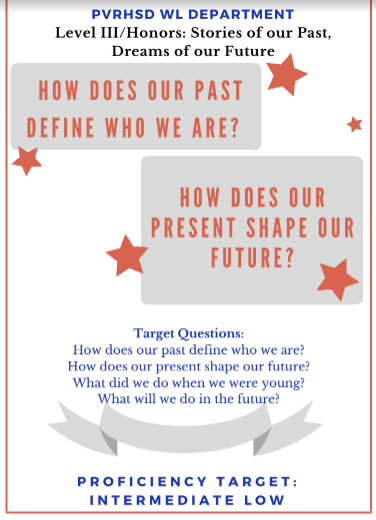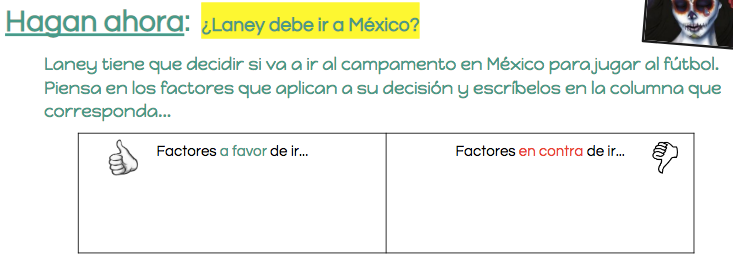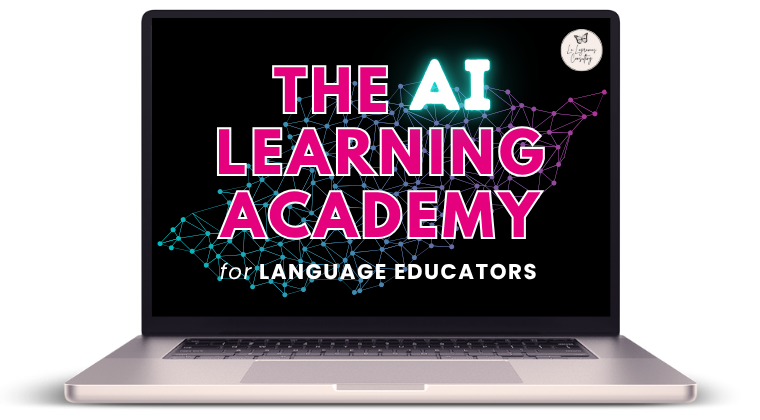A few months ago I had the opportunity to teach Spanish III and we began with the unit, “Stories of the Past, Dreams of the Future”. It was wonderful to return to the classroom and below I share my journey with this common Level III unit.
The unit’s communicative functions & essential questions are:
| -Recount the past-Describe how life used to be
-Compare/contrast life in the past to the present -Compare/contrast present life to the future -Predict the future -Discuss future endeavors |
-How does our past define who we are? -How does our present shape our future? |
And the department established “target questions” to help guide the daily focus of the unit, providing flexibility but also addressing the essential questions & communicative functions.

Working with department colleagues, we established that we would utilize the reader, “La Llorona de Mazatlan” and planned our unit with the reader in mind, with a focus on Mexican culture, stories & legends.
As I began with this unit, I had an approximate window of when this unit would conclude and the different points of entry that I wanted to explore with students, based on the upcoming reader, vocabulary & structures necessary to address these communicative goals. I also started the school year with this unit and choose to focus primarily on describing past events & actions. So I began to plan out my weeks….
Week 1/2: Getting to Know Each Other, Establishing a Classroom Community/Goals & Descriptions of Summer Vacations (Google Slideshow)
Getting to know students and establishing a positive classroom culture is a key ingredient from day one. One way I approached this concept was doing a “Breakout” with students. Thanks to Kristine Keefe-Hasan (@kkeefe_hasan) aka LaProfeAlta, I was introduced to her breakout, Gozadera, which had the students working in teams to try to unlock the puzzles! It was neat to see them working together to build our classroom community during the first few days together. I also used Canva to design my Spanish III syllabus, which was a different way to approach the typical first-day class outline. (rodriguez syllabus espanol iii)
I started off by describing what I had done for the Summer of 2018 and ironically, I had recently taken a trip to Mexico with my family. I was able to provide input through images and video of my experience and as a pre-assessment for students, asked that the students share the same through the creation of a Screencast video of their summer vacations. This provided me with immediate insight as to how well the students could describe past events and from this, I changed my instructional practices to further emphasize descriptions in the past.
Week 3: Highlighting Famous Spanish-Speaking Individuals (Google Slideshow)
After the first class meeting, I knew the students needed way more input! I selected the biographical reader, Vidas Impactantes, and broke the class into six different groups, to allow students to become “experts” on a particular Spanish-speaking individual and to also highlight Hispanic Heritage Month. Students read in class and I utilized the literacy technique of “Reciprocal Reading” as students alternated which role they played as they read in small groups. As a follow-up assessment, students created informative Google Slideshows about their individual to be shared with the class. They were also given an interpretive reading and presentational writing assessment/quiz focused on key vocabulary. This key vocabulary pulled from Vidas Impactantes had a direct correlation to the unit’s essential questions & the upcoming reader: La Llorona.
Week 4/5: El Pasado: Leyendas Mexicanas (Google Slideshow)
These weeks were served as recycling vocabulary from La Llorona, so I continued with my emphasis on input by providing students with (4) Mexican legends that we would read together and discuss. I also provided vocabulary lists through Quizlet, which students practiced with vocabulary both in/out of class. I displayed these lists for students to view & we also “acted” out the words as a whole group.
I utilized different reading techniques such as volleyball translation, whole group reading, popsicle stick reading (randomly calling on students to continue), paired reading and stop/summarize reading. Each legend that students read was read differently. After reading and discussing these different legends, students discussed which was their “favorite” and interviewed my sister-in-law via Skype, who happens to be from Mexico. I also used the song & music video, “Robarte un beso” to emphasize my sister-in-law’s favorite legend: El Callejón del Beso.
Week 6/7/8: La Llorona, Our IPA, The Reader & Mexico: El Presente (Google Slideshow 1 , 2 )
Before diving into the reader, “La Llorona”, I wanted to build background knowledge for the students about this legend. Students completed an EdPuzzle activity for homework and I conducted a MovieTalk narrating the legend using a Youtube video. I posted the La Llorona vocabulary in the back of the classroom, so as I retold the story, I could continue to recycle/emphasize certain words.
At this point, I felt the students were ready to engage in a summative Integrated Performance Assessment with the emphasis of Mexican Legends. Students were provided a different version of La Llorona to read & respond to questions as their interpretive portion, students engaged in a Writers Workshop process by re-writing their own version of their favorite Mexican legend and finally, students had to re-tell their stories/ask questions about one another’s favorite legends for their interpersonal portion via FlipGrid. Questions posed to assist with their conversations were as follows:
Describa tu leyenda mexicana a tu compañero.
¿Quién es parte de tu leyenda? ¿Qué pasó?
¿Cómo terminó tu leyenda? ¿Te gustó la leyenda? ¿Por qué?
We began to read the reader as a class and at this point, because of the backward design process and all of the “preloading” of the important vocabulary that was coming up in this reader, students were able to comprehend 90-95% of the story. In one of the beginning chapter, a discussion between the main character and her father takes place about whether or not Mexico is a safe country. We paused as a class to explore this question and I used materials created by the wonderful Kara Jacobs (@karacjacobs)
Unidad Didáctica: Narcoviolencia en México
to discuss narco-violence. Taking it a step further and hoping to have students further connect, my brother who is a police officer shared via Google Hangouts how widespread the Mexican cartel violence truly is as he described some of his experiences with local gangs and hostage situations. Please know that my intention was not to scare these 10th/11th-grade students but to ensure that they are aware that these crimes are happening globally and also, affecting our communities locally in New Jersey.

A wonderful aspect about these culturally relevant readers is that it does provide a teacher with moments to transition for a bit outside of the reader and dive into a topic that is compelling/interesting for the students to explore & discuss.
My short experience with teaching Spanish III proved that you can utilize common curriculum documents, essential questions, and communicative functions but still allow culture to guide the path & planning of daily lessons. I chose to emphasize Mexico, Mexican culture and legends but there are many different ways one can go to reach that same goal of utilizing a culturally relevant reader with students for communicative purposes!
*A special thank you to Ms. Courtney Farrell (@SrtaFarrell) & Mrs. Ivica Kanova (@ikanova1), Teachers of Spanish at Pascack Valley High School, who served as tremendous resources throughout my planning & unit creation. It was through this collegial collaboration that I gained many new ideas & perspectives!






Srta.,
Increíble. Me encantó este WordPress. Las conexiones no tienen limites.
Gracias por compartir.